3D pens add a new dimension to sketching and doodling. Just like a 3D printer, they heat up plastic filaments and extrude them. But unlike a 3D printer, you don’t need a computer. You can draw freehand or sketch with stencils to create three-dimensional objects.
You may have heard of 3Doodler, the world’s first 3D pen invented in 2012. Since that time, many more brands of 3D pens have appeared. Most of them use fused deposition modeling, or FDM. This simply means they use a process quite similar to a glue gun.
Let’s review the best 3D pens on the market so you can find the perfect one for the artist in you.
| 3D Pens | Features | |
|---|---|---|
| 3Doodler Start Essentials | Nozzle safe to touch, doesn't burn skin Very simple operation, few controls | Check Price |
| Soyan Standard 3D Printing Pen | Versatile—prints with either PLA or ABS filaments from any brand Control extrusion speed | Check Price |
| MYNT3D Professional Printing 3D Pen | Has OLED display that shows temperature and type of material Nozzle is removable for cleaning or replacement | Check Price |
| AIO Robotics Full-Metal Premium 3D Printing Pen | Has OLED display that shows temperature and type of material Nozzle is removable for cleaning or replacement | Check Price |
| 3Doodler Create 3D Pen | Simple controls and ergonomic design Aluminum pen body is lightweight and slender Two extrusion speeds and two temperature settings | Check Price |
| Polaroid Draw 3D Pen | When combined with Trace App, the Draw pen expands the user’s abilities Simple pen operation with fast/slow speed control LED screen shows operating temperature | Check Price |
| Aerb 3D Pen | 8 speed control settings OLED display shows temperature Removable nozzle | Check Price |
| PACKGOUT 3D Doodler | User controls operating temperature and rate of flow Anti-jam design LCD screen | Check Price |
| TIPEYE 3D Printing Pen Kit | Screen shows temperature Three speed settings Aircraft-grade aluminum body | Check Price |
| 3D Pen Printer by TITANIUM MICRO | Speed control LEDs for power and temperature | Check Price |
3Doodler Start Essentials Amazon Exclusive 3D Printing Pen Set—Ideal for Children

The world’s first 3D pen came about because someone’s 3D printer goofed on a print job. The printer left out one line. Since it had already taken hours to get that far, no one wanted to reprint. They disassembled the 3D printer and manually used the extruder head to complete the job. And that’s how 3Doodler got started manufacturing 3D pens.
The Start Essentials Kit is their pen for children. It uses a special biodegradable filament that doesn’t get too hot to touch. If the child using the pen touches the nozzle, they won’t get burned. It’s the only 3D pen in our review today that’s truly safe for children to use.
The pen itself is very simple to operate. There are two buttons—one for the power and one for the extruder. The Start pen only takes a minute to pre-heat, and it’s completely wireless. There are no cords to get in the way.
Of course, it will need to be recharged, but it comes with a standard micro USB port and cable. An LED light changes color depending on whether the pen is charging, heating up, or ready to use.
The pen’s barrel is made to fit comfortably in small hands, and it’s ambidextrous, easy for kids to control. The Start Essentials kit includes a stencil called a “doodleblock” that makes it very easy to draw curved lines and other basic shapes. And since the filament hardens quickly, a child can literally draw shapes in the air.
If you want ideas for what to make with the 3Doodler Start Pen, the company’s website has hundreds of project ideas, including other stencil designs.
- Safe for younger children to use
- Doesn’t get too hot to touch
- Comes with filaments and stencil block
- Very simple to operate
- Quick heat-up time
- Rechargeable, no power cord to get in the way
- Company website offers free ideas and stencils
- Limited to using the 3Doodler filament only, which is PLA
Click here to purchase 3Doodler Start Essentials on Amazon.com!
Soyan Standard 3D Printing Pen—Inexpensive and Versatile for Hobbyists
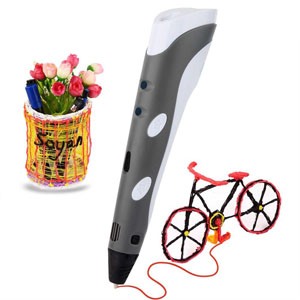
If you’ve been looking at 3D pens for a while, you might recognize the Soyan Standard 3D Pen. It’s similar to pens from brands like Manve and 7Tech, which all seem to be clones of each other. Hobbyists who want to get started with 3D art and printing like the Soyan because it’s cheap and it’s versatile.
It’s versatile because this pen works with both PLA and ABS filament from any manufacturer just as long as it’s the 1.75mm size. You’re not locked into buying a certain brand at all. And that fact makes it cheaper over the long run, too, not just at purchase time.
Next, the Soyan 3D pen lets you have control over the extrusion speed. And since the filament tends to harden immediately, you can easily draw objects vertically, not just horizontally.
Just keep in mind that this pen needs to be plugged into electricity to function. Since the nozzle gets quite hot, it’s best to supervise younger children if they use this device.
Finally, the Soyan kit includes sample filaments and paper templates. Use the templates, or stencils, to get started drawing with your new 3D pen.
- Versatile—prints with either PLA or ABS filaments from any brand
- Control over extrusion speed
- Comes with sample filament and templates
- Simple to operate
- Not for young children without supervision because nozzle will burn skin
- Needs cord and electricity to operate
Click here to purchase Soyan Standard 3D Printing Pen on Amazon.com!
MYNT3D Professional Printing 3D Pen with OLED Display—For Artists Who Want Better Printing Control
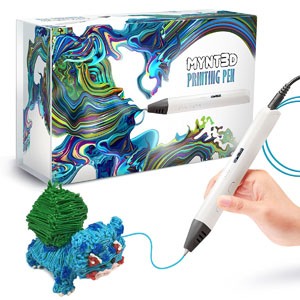
If you’re serious about 3D pen printing and art, you’ll want the best control you can get. The MYNT3D Professional pen handles both PLA and ABS filament with ease, especially since you can set the exact temperature you want, as well as the extrusion speed.
By using the OLED display, you can define the exact temperature, down to 1-degree, between 130 and 240 Celsius, or 266 to 464 F. By experimenting with this feature, you can use decorative filaments, too, like bronze or wood mixtures. The display will also show you which kind of material you are currently using.
If you take advantage of the slider on the side of the pen, you can select the extrusion speed, or simply set it to flow continuously without you needing to hold down the button. This is especially nice when you have a large area to fill in.
Finally, the nozzle on the MYNT3D pen can be removed for cleaning, or replaced if there is a problem in the future.
The pen comes with an AC adapter and three colors of ABS filament. It’s covered by a one-year limited warranty.
- Accepts any brand of filament, either PLA or ABS, and can handle decorative filaments too
- User can control both speed of extrusion and precise temperature
- Has OLED display that shows temperature and type of material
- Nozzle is removable for cleaning or replacement
- Covered by one-year limited warranty
- Comes with sample filaments
- Left-handed users may have difficulty seeing the OLED screen while drawing with the pen
- Not cordless
Click here to purchase MYNT3D Professional Printing 3D Pen on Amazon.com!
AIO Robotics Full-Metal Premium 3D Printing Pen—For Artists Working with PLA Only
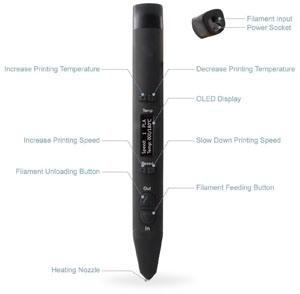
The AIO Robotics 3D pen offers full control similar to the MYNT3D pen, but it only accepts PLA filament. If you’re an artist or hobbyist that’s concerned about plastic and the environment, this may be the best pen for you. PLA is biodegradable, and it’s made from plant starch, which is arenewable resource.
The pen has a slim, all-metal body with a small OLED display. On the display you’ll see the type and temperature of the filament you’re using. Two tiny rock buttons near the screen let you adjust the temperature up or down one degree at a time.
Two other tiny buttons on the other side of the display let you change the extrusion speed. Below them are the filament feed and unload buttons. When you choose a PLA filament to use, you can select any brand you want, as long as its 1.75mm in thickness. This is a time- and money-saving feature over the long run.
The AIO Robotics pen requires external power to run, but you can operate it from a 5V wall charger or a power bank, as long as the current is at least 2Amps. It comes with an AC adapter and cord and sample filament. The pen has both CE and ROHS approval, and it’s covered by a one-year manufacturer’s warranty.
- All-metal slim pen body
- Control over temperature and extrusion speed
- OLED display
- Can run off electrical mains or external power bank as long as voltage and current are sufficient
- CE and ROHS approval
- Not locked into using any particular brand of filament
- 1-year warranty
- Not wireless, cordless, or rechargeable
- Only works with PLA filament
Click here to purchase AIO Robotics Full-Metal Premium 3D Printing Pen on Amazon.com!
3Doodler Create 3D Pen—Easy to Use for Adult Artists and Hobbyists
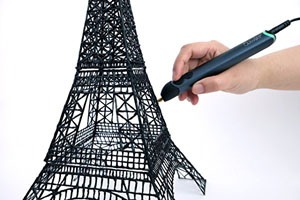
The 3Doodler Create is the adult version of the 3Doodler Start pen at the top of this article. It has advanced features for artists and hobbyists, like the ability to use PLA, ABS, and other flexible filaments. Plus, 3Doodler has many accessories available for use with the Create pen, including the DoodlePad, the JetPack, and a foot pedal to control the extrusion (instead of pressing a button).
While you’ll be locked into using only 3Doodler filaments, they have a wide selection of colors and textures, including glow-in-the-dark and sparkly plastics. Their website offers hundreds of free stencils, too.
The Create pen itself has a pleasant design. The lightweight aluminum body has ergonomic control buttons for temperature control and extrusion speed. But you won’t have as much control over those two factors as you would with some of the other 3D pens in our review.
Instead, the 3D Create pen is quite simple to use. There are only two choices for heating it—high for ABS and FLEXY filaments, and low for PLA. And you can extrude the filament either fast or slowly.
But if you’re anxious to get started on 3D art with a pen, the Create is a great choice for beginning artists. It comes with fifty strands of colored filament and a power adapter, plus your purchase is protected by a 360-day replacement policy and round-the-clock customer service.
- Simple controls and ergonomic design
- Aluminum pen body is lightweight and slender
- Works with 3Doodler filaments like ABS, PLA, glow-in-the-dark, and FLEXY
- Two extrusion speeds and two temperature settings
- Comes with 50 filament samples
- Covered by 36-day replacement policy
- Must use 3Doodler filaments
- Not cordless or wireless
Click here to purchase 3Doodler Create 3D Pen on Amazon.com!
Polaroid Draw 3D Pen for Aspiring Artists Who Want Guidance and Ideas, Has Stencil App
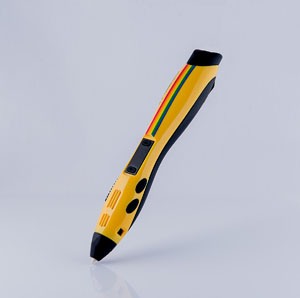
Polaroid makes the Draw 3D Pen for both children and adults who are fascinated with three dimensional art projects. The best feature is the ability to use the Polaroid Play Trace App that turns any photo into a stencil. Plus, Polaroid also offers a large gallery of their own stencils online, too.
The Draw pen is similar to many other 3D pens on the market. It has two buttons to increase or decrease the extrusion speed. It also has an LED display that shows the operating temperature and the PLA setting. And that’s the main downfall of the Draw—it only works with PLA filament. But it comes with 65 feet for free to get you started.
The box includes a Trace App screen protector for a tablet and four adhesive pads to hold your artwork steady on a surface while you work. There’s also a pen holder stand, USB cable, and an AC adapter.Polaroid offers a one-year full warranty plus toll-free phone support.
- When combined with Trace App, the Draw pen expands the user’s abilities
- Trace App turns photos into stencils
- Polaroid offers free stencils online
- Simple pen operation with fast/slow speed control
- LED screen shows operating temperature
- 1-year full warranty plus toll-free phone support
- Limited to using Polaroid’s PLA filament only
Click here to purchase Polaroid Draw 3D Pen on Amazon.com!
Aerb 3D Pen—Very Good Choice for Enthusiasts
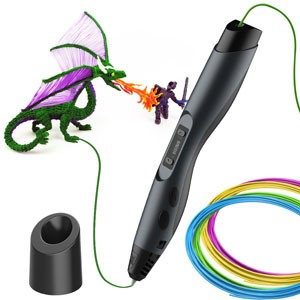
If you compare the Aerb 3D pen to the Polaroid Draw, do you see the similarities? Their shapes are similar, they both have displays that show the operating temperature, and they both come with a pen stand. But let’s show you where these two pens differ.
First, the Aerb works with either PLA or ABS filament as it can operate between 160 and 210 degrees F. That means you can use any kind or color as long as it is 1.75mm in thickness.
Second, while the Polaroid Draw lets you speed up or slow down the rate of flow, the Aerb has 8 speed control settings for more precise extrusion. It’s simple to load and unload a filament to switch colors during a project. And the nozzle itself is removable so you can clean it or replace it.
If you want more control and flexibility than some of the big brands can give you, check out the Aerb and other clone 3D pens. Many times you’ll get plenty of value at a low price.
- Works with any brand of 1.75mm ABS or PLA filament
- 8 speed control settings
- OLED display shows temperature
- Removable nozzle
- Comes with filament samples
- Not cordless and can’t run off power bank, requires 12V 2A electricity
Click here to purchase Aerb 3D Pen on Amazon.com!
PACKGOUT 3D Doodler—Perfect for Hobbyists and Artists on a Budget
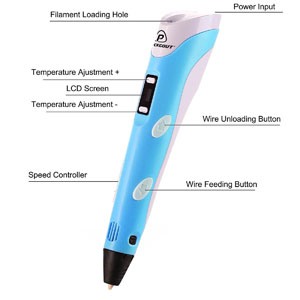
The PACKGOUT 3D pen, just like the one from Soyan, doesn’t care if you use ABS or PLA filament. It’s not picky about brand, either. You can set the flow rate, or extrusion speed, as well as the nozzle temperature. This is yet another clone 3D pen that’s perfect for hobbyists and enthusiasts on a budget.
The pen also has a nice bundle of features like a quiet fan, an anti-jam design, and a built-in unclogging mechanism. There’s even a power-saving safety procedure: the pen enters a standby mode if it sits unused for 5 minutes.
On the LCD screen you can see the operating temperature. Below the screen and to the right side, you’ll find the speed controller. Just one note about this—PACKGOUT recommends not using the pen at a high rate of speed if the temperature is low because it could cause a jam. But in the worst case scenario, you can remove and replace the nozzle if needed.
The PACKGOUT 3D pen comes with a 1-year guarantee, a power adapter, 30 grams of 1.75mm PLA filament, and access to free templates online.
- Works with ABS or PLA filament
- User controls operating temperature and rate of flow
- Anti-jam design
- LCD screen
- Quiet operation
- Standby mode after 5 minutes of inactivity
- 1-year warranty
- Comes with sample filament
- Not cordless or wireless, requires electricity
Click here to purchase PACKGOUT 3D Doodler on Amazon.com!
TIPEYE 3D Printing Pen Kit—Freedom of Choice for Artists and Hobbyists
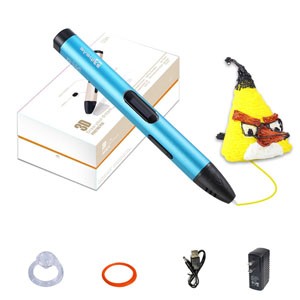
You may notice that the TIPEYE 3D pen design is reminiscent of the 3Doodler Create. But TIPEYE sets you free from having to use any particular brand of filament. In fact, you are free to use either ABS or PLA. And although you’ll need external power to use this pen, you can run it off a power bank instead of mains electricity.
TIPEYE gives two bits of advice so you have the best experience. One, they do not recommend using PCL filament. And two, should you use a power bank, make sure it outputs 5V 2Amps and has at least 40% of its charge left.
The slender body of the pen is built with aircraft-grade aluminum. It has a small display that reveals the operating temperature since you can adjust that from 180 to 220 degrees Celsius. There is a selector button for the print speed with three settings for low, medium, and high. If the pen is inactive for 3 minutes, it will enter standby mode. Just press the load button to activate it again.
The TIPEYE pen comes with a pen holder, a USB cable with AC adapter, and a sample of PLA filament. The nozzle is replaceable, too. The pen is covered by a 30-day return or replacement policy, a 1-year warranty, and lifetime customer support.
- Accepts both PLA and ABS filament
- Operates between 180 to 220 C
- Screen shows temperature
- Three speed settings
- Standby mode after 3 minutes of inactivity
- Aircraft-grade aluminum body
- Runs off 5V 2A power—compatible with mains electricity, some USB ports, and power banks
- 30-day return policy, 1-year warranty, and lifetime customer support
- Not cordless, but is portable with a power bank
Click here to purchase TIPEYE 3D Printing Pen Kit on Amazon.com!
3D Pen Printer by TITANIUM MICRO—Inexpensive Pen for Children or Adults
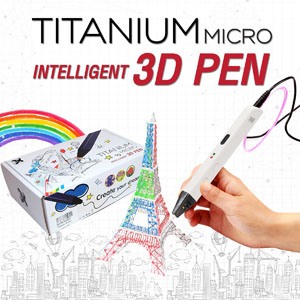
TITANIUM MICRO’s 3D pen printer is marketed toward children, but the body of the pen might be a little large for small hands to manage. On the upside, it’s lightweight and simple to operate.
There are two LED lights that indicate if the pen is powered on and if it’s hot and ready to use. Since you’ll need to use TITANIUM MICRO’s own filament, you don’t need to worry about temperature settings for different materials. But you can change the extrusion speed if you like.
The pen uses 5V power, so it can run off the included wall adapter or your own power bank for portability. It comes with 30 feet of filament in the box.
- Inexpensive and simple to use
- Speed control
- LEDs for power and temperature
- Can run off electricity or power bank
- Comes with 30 feet of filament
- Uses proprietary filament
- Not cordless, but can be portable when used with a power bank
Click here to purchase 3D Pen Printer by TITANIUM MICRO on Amazon.com!
Buyer’s Guide to Choosing the Best 3D Pen
Now that you’ve seen the top 3D pens, all that’s left to do is choose between them. Here are some tips for selecting the best 3D pen for your projects.
Features like temperature and speed controls
Are you purchasing a 3D pen for a child, an adult, or a variety of users? What is their level of experience?For example, you may prefer a simple pen that doesn’t get too hot to touch if you buy for a child. But an adult with experience drawing 3-dimensional objects will probably prefer precise temperature and speed controls.
Size and weight of the pen, plus the location of controls
Take into account the size of the pen compared to the size of the user’s hand. Consider the placement of the flow rate controls if the person is left-handed. Also ponder whether the pen might be too awkward or heavy for the intended user.
Some pens have plastic bodies; others have metal casings. Some controls slide, while others are push buttons. And some of those buttons are pretty small for people with large fingers. Take a good look at the item’s photos and videos, and see it in person before buying, if possible.
Corded or cordless, plus portability
Many of the less expensive 3D pens are corded. They run off regular electricity from the wall. But some are rechargeable, and others can operate from a portable external power source like a computer’s USB port or a cell phone power bank. Think about whether a cord is going to get in your way, and whether you might like to carry your pen to draw away from home.
Compatible filaments
The type of filaments you can use with any given pen will make or break that pen’s usability down the road. For example, if you purchase a pen that requires the use of a proprietary filament, and that manufacturer goes out of business, you’ll have an electronic device that is useless. Or if you have a 3D pen that’s compatible with only one kind of filament, but later you want to work with a different substance, you’ll need to buy a new pen.
Proprietary filaments have both pluses and minuses. The plus is that you’re likely to have fewer jams or other problems. The minus is that you’ll be forced to pay whatever price the manufacturer sets for as long as you stay in their ecosystem.
Finally, remember that ABS filaments are better for items that need to be flexible and resistant to heat and impacts. A smartphone case is a good example of an ABS project. Meanwhile, PLA is fine for sculptures, models, and other kinds of art and low-wear toys. And if you want to make decorative projects that are luminescent or sparkly, check ahead of time where you can purchase the filament you need.
Bonuses like apps, accessories, and stencils
Depending on the manufacturer, your new 3D pen may come with a variety of bonuses like free stencils or an app for your tablet or smartphone. If the ability to expand beyond the basics is important to you, buy from manufacturers that offer extras like these, or sell accessories for your pen.
3Doodler is a good example of a manufacturer with a diverse ecosystem of accessories. They offer some products for free, like stencils you can download and print. But they also sell items like a foot pedal to control extrusion and rest your hand.
Polaroid, on the other hand, has an app for that. Well, it’s an app that lets you trace an image and turn it into a 3D object. Take into account all that a company offers because you never know how far you’ll take your new hobby once you begin.
Safety features
One last important aspect to consider when buying a 3-D pen are its safety features. These may range from a standby mode after a few minutes of inactivity, to a nozzle that doesn’t get too hot to touch and won’t burn kids.
Why are filaments important?
The kind of 3D printing you can do is limited to the type of filaments you can use with your pen.
PLA, or biodegradable polylactic acid, requires a lower temperature to melt. It’s a little more likely to cause a jam because it’s rather sticky when it’s molten. But it doesn’t have a burning plastic smell like ABS. It’s also great for printing with a pen because it can cool quickly without warping or cracking.
ABS, or acrylonitrile butadiene styrene, is a plastic made from oil. Objects printed with ABS are more durable and flexible. But ABS stinks when it’s heated, and it can warp if it cools off too fast. On the other hand, it’s rare to have a nozzle clog when printing with ABS.
Both ABS and PLA can be blended with other materials like wood and metal to make decorative filaments. You’re likely to find every color of the rainbow, plus glitter and glow-in-the-dark dyes.
If you plan to print objects that require flexibility, and impact and heat resistance, go with ABS filament. You can glue ABS plastic, file it, sand it, and treat it with acetone. You can also recycle it when you’re done. People who make phone cases, electrical enclosures, mechanical parts like cogwheels, and tool handles usually choose ABS for the job.
If you want to stay friendly to the environment, choose PLA filament. It’s biodegradable and recyclable. While you can cut, file, and sand it, it’s difficult to glue and acetone washes will dissolve it. PLA is the most common choice for prototype mockups, containers, models, and toys that won’t get heavy wear.
One last note: keep any kind of filament in a sealed container when not in use. This is because both ABS and PLA can absorb moisture, which will degrade their performance.
Tips for successful 3D printing with a pen
When you’re new to using a 3D pen, or even 3D printing in general, there are a few things that can make your introduction easier.
Smooth flowing without jams
3D pens can occasionally jam, but you can avoid most problems with a couple of simple tricks. One is to trim the end of a partially-used filament strand before you load it. Snip off any deformation with a pair of scissors. Two is to avoid using the high speed setting when you’re operating at a low temperature.
Getting used to drawing with a 3D pen
A lot of new users practice by doing 2D sketches on a stencil, or template. Print out a simple design on paper, then place just one small dot as your anchor point on the paper. Don’t break the flow of the plastic, simply continue moving the pen slowly while extruding the filament as you trace the pattern you printed.
The filament should stick to the paper as it cools and hardens. When you want to break off the flow, just wait for a moment while the plastic cools, then remove the pen. You can smooth down unruly points by reheating them and pressing them down with the point of the pen when it’s not extruding.
You can also smooth rough-looking sketches by placing them in the oven for a few minutes. Select a temperature just a bit higher than the melting point of the filament. Your design should soften up and smooth out somewhat.
Making 3D objects with a pen and stencil
Once you’ve gotten the hang of sketching with the pen, try assembling a 3D object from parts you draw. Many of the pen manufacturers offer free templates for you to trace and fill in. Once those individual objects are built, you can join them together, like building a house with four walls and a roof that you drew separately.
Freehand drawing with a 3D pen in the air
Possibly the most exciting feature of a 3D pen is the ability to draw in the air. This requires you to move at the same speed that the nozzle extrudes filament, which may be very slow. Begin by placing a large dot, or anchor point, on your working surface. Then move the pen slowly upward and away from the anchor. As the plastic cools, it solidifies enough to support itself in an upright column.
To make curved lines, you may need to draw a straight line in the air, then reform it with your hands into an arch. You can also join separate lines by pausing with the pen to heat up and melt the connection between the parts so it will solidify as one piece.
Cleanup after using a 3D pen
The best practice is to never put your pen away with leftover filament inside it. That includes the nozzle. You may have to remove and clean out the nozzle, if that’s possible with your model of pen. Some brands let you completely replace the nozzle with a new one.
Most filament manufacturers will tell you to never use less than a one-inch remnant of filament in your pen. Small bits like that can cause jams. While some 3D pens are simple to disassemble, others are difficult or impossible to open safely. It’s best to avoid problems in the first place.
Recommendation
To help you further narrow down your choices today, here are our recommendations.
For young children, you can’t go wrong with the 3Doodler Start Essentials Kit. The Start Pen is safe for kids because it doesn’t get too hot to touch. It’s rechargeable, so there is no power cord to get in the way. And the kit comes with accessories to help your little one get a great start in the world of 3D art. The only downside is that you’ll be limited to 3Doodler’s own filament.
If you’re buying for older children and teens, take a look at the Polaroid Draw. While it’s a rather basic 3D pen, it works with Polaroid’s Trace App that helps anyone turn a photo into a 3D object, one stencil at a time. And the pen comes with screen protectors in the box so you can get started drawing right on your tablet.
Adults who want to begin working with 3D printing pens, but don’t want to deal with complicated controls, might prefer these three models: 3Doodler Create, TITANIUM MICRO, and Soyan. Each is very simple to operate, but Soyan is the only one of the three that allows you to choose the brand of filament you use.
For hobbyists and enthusiasts who want maximum control, check out AIO Robotics, Aerb, and PACKGOUT’s 3D Doodler. These pens let the user control both the temperature and the flow rate, plus they are compatible with either ABS and PLA filaments.
Finally, artists will appreciate the TIPEYE 3D Printing Pen Kit and the MYNT3D Professional Printing 3D Pen. Both allow maximum control and work with multiple types of filaments. Both are covered by one-year warranties, too.
Conclusion
We hope our reviews helped you find the perfect 3D pen today. We wish you many hours of enjoyment with it. Visit us again soon to get insights on the best tech gadgets for the money.